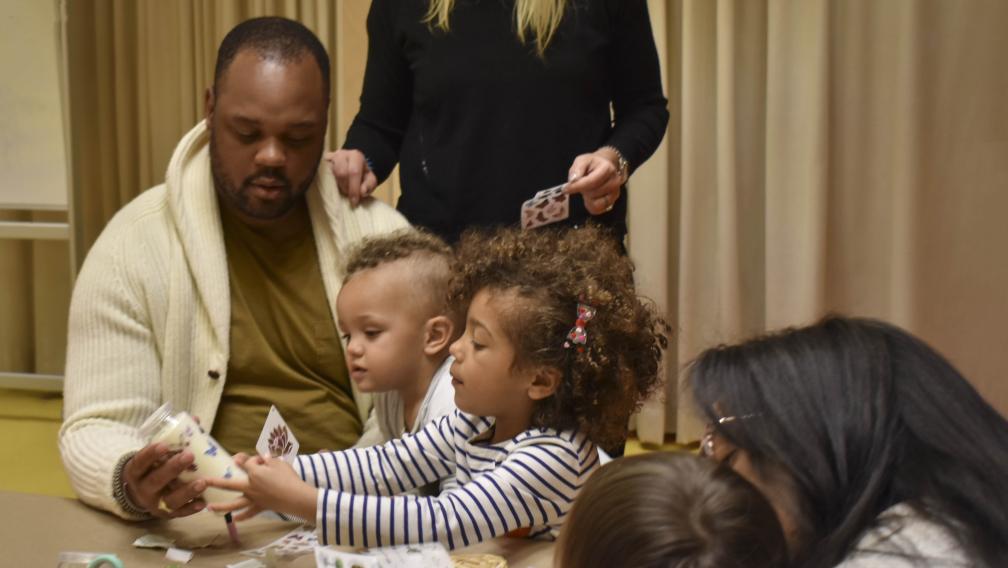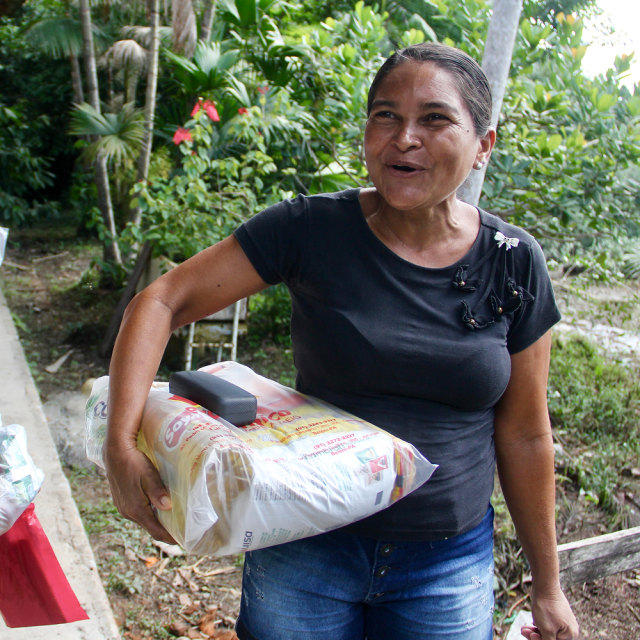Lent with Kids: How to Start a New Family Tradition

Lent is full of opportunities for deeper connection with God and with each other. Here are some simple ways young families can experience the season together.
Lent is a season of stillness — a time when we are invited to reflect on our lives, remember what it means to be loved by God, and prepare for the promise of Easter. For Trinity parents like Christina McLeod, who grew up observing Lent, it’s important that children also get to experience all the spiritual nourishment the season offers, especially in a city as fast-paced as New York.
“New York families are so busy all the time; we don’t have a lot of time and space to think,” said McLeod, whose two children have attended Trinity's Sunday School. “But I want that to be part of my kids’ lives. I want them to grow up knowing how important it is to pause and reflect.”
Families are often searching for ways to introduce children to the stories, traditions, and significance of Lent and Holy Week, according to Kathryn Carroll, Trinity’s program manager for Children and Families. Given the contemplative nature of this period of the liturgical calendar — and its focus on weighty topics like Jesus’s death and resurrection — getting started can be daunting.
Responding to this need, Carroll’s team has spent the past few years designing Lenten experiences for children between 2 years and fifth grade, the age range served by Trinity’s Sunday School. Their hope is that through events like the Family Lenten Workshop, families will have all the resources they need to walk through this season together.
“Lent is a wonderful opportunity for both parents and kids to try something new,” Carroll said. “There are daily practices families can experiment with and make lasting parts of a family’s life.”
Carroll’s best advice for parents? Take the pressure off. Children in this age range are concrete thinkers, she said, which means sharing an experience together is more effective than sharing complicated concepts. That could mean taking 20 minutes in a day to feed a sourdough starter, which is what Trinity’s Sunday School encouraged families to do for Lent last year. It could be a craft activity, like “Holy Week in a Box,” which uses objects found around the home to tell Jesus’s story from Palm Sunday to Easter. Or it could be something as simple as making appreciation cards for friends or teachers.
“Children are innately quite spiritual. They have the capacity to experience the sacred through all their senses,” Carroll said. “So when they’re young, we lean into sensory, relational, and experiential learning. We begin planting the seeds of stories and practices, so they're ready for more complicated theological concepts when they move into adolescence.”
Carroll advises parents to use clear, simple language when talking about Lent, describing it as a time when we “get ready” for the “mystery of Easter.” During Holy Week, when the most challenging parts of Jesus’s story unfold, focus on the emotions of the people involved instead of details about Jesus’s physical suffering. And talk about the resurrection as an opportunity for Jesus to be “with us in a new way.”
It’s important to strike a balance between being direct with kids and being careful not to speak over their heads, Carroll said.
“As adults, we tend to throw around words like resurrection and redemption, which are quite complex. If kids don’t ask for clarification, they will eventually come to their own conclusions, which may not be for the best,” she said. “So we use plain language to explain these concepts. And we try to develop inviting experiences and themed lessons around scripture and worship that parents can continue at home.”
One way to bring the mystery of Easter home, suggests Carroll, is to create a Paschal Candle for the family. Traditionally lit at church during the Easter Vigil service on the night before Easter and often embellished with decorative elements, Paschal Candles are easy to make with store-bought tall white pillar candles and stickers or paint pens. The candle can be hidden or covered until Easter, then placed on display, offering kids a visual representation of the light Jesus brought into the world through the resurrection.
Another way to mark the passing of the season is with a simple weekly Sunday reflection, prayer, or practice that parents and children participate in together. Practices could be activities that families can give up or take on—like cutting out negative self-talk or caring for the earth by taking extra efforts to consume less. (More ideas below!)
When adding a ritual to your family routine, don’t force anything, Carroll said. It’s okay to drop an idea if children can’t keep up. “We try not to present faith as something to achieve, but as way for children to receive and share God’s gifts, Jesus’s love, and their own love,” she said. “These practices are a way of making room for God’s presence on purpose.”
McLeod still cherishes her memories of last year’s Lent, when her kids loved the hands-on nature of making sourdough as a family. “It gave us a 20-minute pause in our busy day. No one was on a device. Everyone just gathered in the kitchen, chatting and reflecting,” she said. “It ended up being a very special time.”
This is exactly the kind of sacred space Trinity hopes families create during Lent, according to the Rev. Matthew Welsch, priest and director for Children, Youth and Family.
“These are the moments, as short as they may be, that bring families closer to God and to each other,” he said. “God is always with us, but sometimes we need to be intentional about noticing and receiving God’s love. And Lent is a great time for families to start practicing that together.”
Lent Resources for Families
From simple spiritual practices to hands-on activities, Trinity’s Children and Families team offers useful ideas to get you started.
Activities
Interested in making your own Paschal Candle? This video shows you how.
Teach your kids to make a sourdough starter and keep feeding it throughout Lent. On Maundy Thursday, choose a bread recipe to make together. (You could try hot crossed buns, savory focaccia, an Easter bread, or another family favorite!) Prepare your dough on Holy Saturday and bake on Easter Day.
Print out a Lenten Calendar to keep track of your family’s journey to Easter. Consider praying for a different person every day.
Use materials you find around the house to create Holy Week in a Box, which will help you tell Jesus’s story from Palm Sunday to Easter.
Practices
Consider taking on a Lenten ritual as a family. Choose a different practice for each week of the season or just try one out for a few days.
Lent is an opportunity to consider what habits we might put aside to make more room for God. Choose one thing to give up as a family:
Complaining
Consuming
Worrying
Negative self-talk
Comparing yourself to others
Lent allows us to pay attention to our living and how it impacts the world. Choose one way to care for the earth:
Recycling
Composting
Turning off the lights
Biking or walking instead of driving
Urging your elected representatives to support environmental protection legislation
During Lent, we forgive others — and ourselves. When you’re feeling down, choose one thing to remember:
It’s okay to make mistakes.
It’s okay to have bad days.
It’s okay to start again.
It’s okay to be awesome.
Lent is not just about giving things up, but about exploring new ways to experience and share God’s love. Choose a positive practice to add to your life:
Pick up trash in the neighborhood.
Put out bird seeds for the birds.
Give outgrown clothing to a smaller friend.
Draw a picture for your librarian or mail carrier, with a note saying, “Thank you!”
Things to Read and Watch Together
Books
Make Room: A Child's Guide to Lent and Easter, by Laura Alary, shows how acts of kindness can help children create space for God. (Grades 3–7)
In Sparrow's Prayer, author Roger Hutchison uses a simple story to illustrate how we can pray without words. (Grades 1–2).
What We Do in Lent: A Child's Activity Book, by Anne E. Kitch, is filled with mazes, crossword puzzles, and other fun games that teach children about Lent. (Grades Preschool – 2)
Videos
The English artist Simon Smith has created 40 illustrations that together tell the story of Jesus’s 40-day fast in the wilderness.
The Godly Play Foundation, which creates the Montessori-influenced children’s curriculum used by Trinity Church, has a number of helpful video resources. “The Mystery of Easter” uses six puzzle pieces to explain how the six weeks of Lent help us prepare for Easter. “Jesus and Jerusalem” uses a 3D map of the holy city to tell the story of Holy Week. And the “Faces of Easter” (a seven episode series) tells Jesus’s entire life story, with the aim of showing how his footsteps led to the cross and to resurrection.





